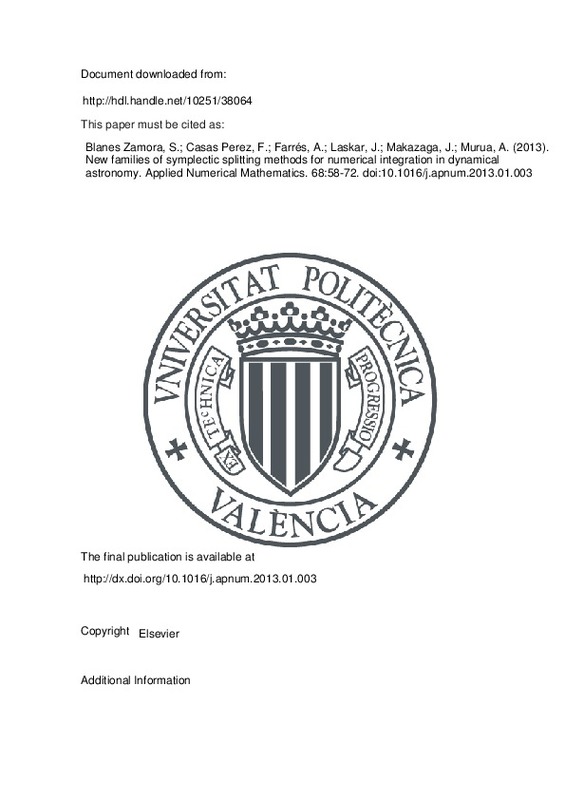JavaScript is disabled for your browser. Some features of this site may not work without it.
Buscar en RiuNet
Listar
Mi cuenta
Estadísticas
Ayuda RiuNet
Admin. UPV
New families of symplectic splitting methods for numerical integration in dynamical astronomy
Mostrar el registro sencillo del ítem
Ficheros en el ítem
| dc.contributor.author | Blanes Zamora, Sergio
|
es_ES |
| dc.contributor.author | Casas Perez, Fernando
|
es_ES |
| dc.contributor.author | Farrés, Ariadna
|
es_ES |
| dc.contributor.author | Laskar, Jacques
|
es_ES |
| dc.contributor.author | Makazaga, Joseba
|
es_ES |
| dc.contributor.author | Murua, Ander
|
es_ES |
| dc.date.accessioned | 2014-06-10T15:49:24Z | |
| dc.date.issued | 2013-06 | |
| dc.identifier.issn | 0168-9274 | |
| dc.identifier.uri | http://hdl.handle.net/10251/38064 | |
| dc.description.abstract | [EN] We present new splitting methods designed for the numerical integration of near-integrable Hamiltonian systems, and in particular for planetary N-body problems, when one is interested in very accurate results over a large time span. We derive in a systematic way an independent set of necessary and sufficient conditions to be satisfied by the coefficients of splitting methods to achieve a prescribed order of accuracy. Splitting methods satisfying such (generalized) order conditions are appropriate in particular for the numerical simulation of the Solar System described in Jacobi coordinates. We show that, when using Poincaré Heliocentric coordinates, the same order of accuracy may be obtained by imposing an additional polynomial equation on the coefficients of the splitting method. We construct several splitting methods appropriate for each of the two sets of coordinates by solving the corresponding systems of polynomial equations and finding the optimal solutions. The experiments reported here indicate that the efficiency of our new schemes is clearly superior to previous integrators when high accuracy is required. | |
| dc.description.sponsorship | The work of S.B., F.C., J.M. and A.M. has been partially supported by Ministerio de Ciencia e Innovacion (Spain) under project MTM2010-18246-C03 (co-financed by FEDER Funds of the European Union), whereas A.F. and J.L. acknowledge financial support by the FP7 GTSnext project. | en_EN |
| dc.language | Inglés | es_ES |
| dc.publisher | Elsevier | es_ES |
| dc.relation.ispartof | Applied Numerical Mathematics | es_ES |
| dc.rights | Reserva de todos los derechos | es_ES |
| dc.subject | Symplectic integrators | |
| dc.subject | Splitting methods | |
| dc.subject | Near-integrable systems | |
| dc.subject | N-body problems | |
| dc.subject.classification | MATEMATICA APLICADA | es_ES |
| dc.title | New families of symplectic splitting methods for numerical integration in dynamical astronomy | es_ES |
| dc.type | Artículo | es_ES |
| dc.embargo.lift | 10000-01-01 | |
| dc.embargo.terms | forever | es_ES |
| dc.identifier.doi | 10.1016/j.apnum.2013.01.003 | es_ES |
| dc.relation.projectID | info:eu-repo/grantAgreement/MICINN//MTM2010-18246-C03/ | |
| dc.relation.projectID | info:eu-repo/grantAgreement/EC/FP7/215458/EU/Towards the next generation of the Geological Time Scale for the last 100 million years – the European contribution to EARTHTIME/ | |
| dc.rights.accessRights | Abierto | es_ES |
| dc.contributor.affiliation | Universitat Politècnica de València. Departamento de Matemática Aplicada - Departament de Matemàtica Aplicada | es_ES |
| dc.description.bibliographicCitation | Blanes Zamora, S.; Casas Perez, F.; Farrés, A.; Laskar, J.; Makazaga, J.; Murua, A. (2013). New families of symplectic splitting methods for numerical integration in dynamical astronomy. Applied Numerical Mathematics. 68:58-72. https://doi.org/10.1016/j.apnum.2013.01.003 | es_ES |
| dc.description.accrualMethod | S | es_ES |
| dc.relation.publisherversion | http://dx.doi.org/10.1016/j.apnum.2013.01.003 | es_ES |
| dc.description.upvformatpinicio | 58 | es_ES |
| dc.description.upvformatpfin | 72 | es_ES |
| dc.type.version | info:eu-repo/semantics/publishedVersion | es_ES |
| dc.description.volume | 68 | es_ES |
| dc.relation.senia | 255337 | |
| dc.contributor.funder | Ministerio de Ciencia e Innovación | |
| dc.contributor.funder | European Commission | |
| dc.contributor.funder | European Regional Development Fund |







![[Cerrado]](/themes/UPV/images/candado.png)

